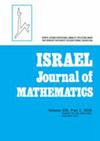On minimal generating sets for the mapping class group of a punctured surface
IF 0.8
2区 数学
Q2 MATHEMATICS
引用次数: 0
Abstract
Let Σg,p be an oriented surface of genus g with p punctures. We denote by \(\cal{M}_{g,p}\) and \(\cal{M}_{g,p}^{\pm}\) the mapping class group and the extended mapping class group of Σg,p, respectively. In this paper, we show that \(\cal{M}_{g,p}\) and \(\cal{M}_{g,p}^{\pm}\) are generated by two elements for g ≥ 3 and p ≥ 0.
关于点状曲面映射类群的最小生成集
让 Σg,p 是一个具有 p 个穿刺的 g 属定向曲面。我们分别用 \(\cal{M}_{g,p}\) 和 \(\cal{M}_{g,p}^{\pm}\) 表示 Σg,p 的映射类群和扩展映射类群。在本文中,我们证明了对于 g ≥ 3 和 p ≥ 0,\(\cal{M}_{g,p}\)和\(\cal{M}_{g,p}^{\pm}\)由两个元素生成。
本文章由计算机程序翻译,如有差异,请以英文原文为准。
求助全文
约1分钟内获得全文
求助全文
来源期刊
CiteScore
1.70
自引率
10.00%
发文量
90
审稿时长
6 months
期刊介绍:
The Israel Journal of Mathematics is an international journal publishing high-quality original research papers in a wide spectrum of pure and applied mathematics. The prestigious interdisciplinary editorial board reflects the diversity of subjects covered in this journal, including set theory, model theory, algebra, group theory, number theory, analysis, functional analysis, ergodic theory, algebraic topology, geometry, combinatorics, theoretical computer science, mathematical physics, and applied mathematics.

 求助内容:
求助内容: 应助结果提醒方式:
应助结果提醒方式:


